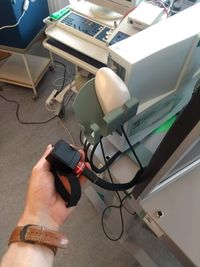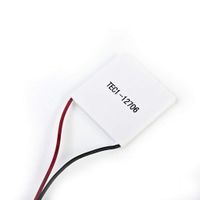Difference between revisions of "Thermal pain device"
| (10 intermediate revisions by the same user not shown) | |||
| Line 1: | Line 1: | ||
| + | [[File:Existing_peltier.jpg|200px|thumb|right|Existing (expensive) heating device]] | ||
| − | + | In this project you will be working with The Spinecenter of Southern Denmark, located in Middelfart [http://www.sygehuslillebaelt.dk/wm202525] to construct a device for measuring levels of thermal pain in patients with chronic low back pain. In the lab at the Spinecenter the primary focus of research is patient centered, trying to better diagnose and help patients with chronic low back pain. In their research they use various devices to induce pain on patients, to measure when a patient starts(!) feeling pain (pain threshold). The problem with their current equipment is, that it is either very expensive or not very user friendly. | |
| − | + | The job will be to construct a device to induce a measurable amount of pain on patients and log the data. | |
| − | + | == Example of device == | |
| + | One example is using a Peltier module (heating plate) that the patient will place his hand on, and remove the hand when he starts feeling pain. A thermistor wil then sense the temperature and the data (temperature + time on plate) can be logged for further use. The interface on the device could be made simply with an LCD screen and a few buttons connected to an Arduino. | ||
| + | The user interface should be easy to use, so that the patient can use the device on his own, freeing up time for the clinician. | ||
| − | + | [[File:peltier.jpg|200px|thumb|right|Example of (cheap) Peltier module]] | |
| − | |||
| − | |||
| − | |||
| − | |||
| − | |||
| − | |||
| − | |||
| − | |||
| − | |||
| − | |||
== Perspective == | == Perspective == | ||
The aim is for this (or a similar) device to be available for clinicians nation-wide, so any patient can be easily tested. | The aim is for this (or a similar) device to be available for clinicians nation-wide, so any patient can be easily tested. | ||
Latest revision as of 15:02, 15 November 2018
In this project you will be working with The Spinecenter of Southern Denmark, located in Middelfart [1] to construct a device for measuring levels of thermal pain in patients with chronic low back pain. In the lab at the Spinecenter the primary focus of research is patient centered, trying to better diagnose and help patients with chronic low back pain. In their research they use various devices to induce pain on patients, to measure when a patient starts(!) feeling pain (pain threshold). The problem with their current equipment is, that it is either very expensive or not very user friendly. The job will be to construct a device to induce a measurable amount of pain on patients and log the data.
Example of device
One example is using a Peltier module (heating plate) that the patient will place his hand on, and remove the hand when he starts feeling pain. A thermistor wil then sense the temperature and the data (temperature + time on plate) can be logged for further use. The interface on the device could be made simply with an LCD screen and a few buttons connected to an Arduino. The user interface should be easy to use, so that the patient can use the device on his own, freeing up time for the clinician.
Perspective
The aim is for this (or a similar) device to be available for clinicians nation-wide, so any patient can be easily tested.

